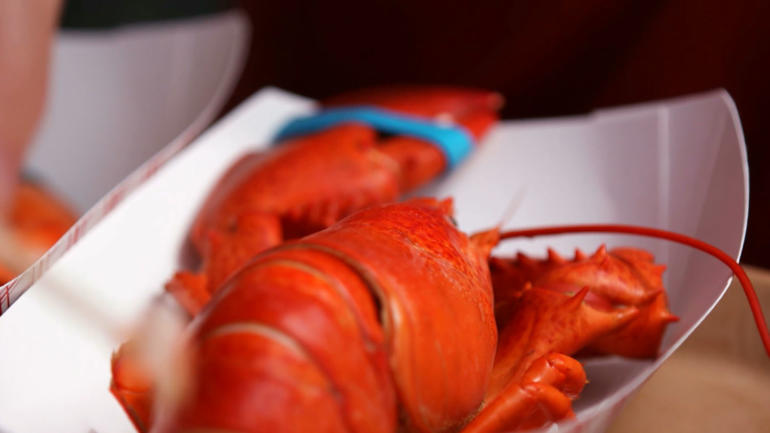The U.S.-China trade war is hitting one U.S. state particularly hard.
This month, China slapped the U.S. lobster industry with a 35 percent retaliatory tariff – up 10 percent from last year.
Most of the U.S. lobster supply comes from the state of Maine – where lobster exports to China have plummeted more than 80 percent.
CGTN’s Frances Kuo traveled there for a closer look at the impact.
With more than five-thousand kilometers of coastline, Maine doesn’t fall short of stunning scenery. The views are matched only by the state’s other big attraction: lobsters.
“It’s a sweet taste, more sweet than seafood taste,” says one lobster fan.
“There’s no other taste like lobster, especially Maine lobster,” says another lobster enthusiast.
Stephanie Nadeau, owner of “The Lobster Company,” a lobster distributor outside Portland, describes lobsters as “happy party food.”
But she has little to celebrate these days. Nadeau used to do half her business in China – that accounts for about 900,000 kilograms of lobster a year – And now?
“None. Zero. No, we have no clients at all in China. Now, all the business is done by Canadian firms.”
Nadeau is trying to keep the company afloat as Canada takes over the Chinese market – without the tariff-inflated price tag.
“It’s like Christmas in Canada every day,” describes Nadeau.
The tariffs have forced her to lay off half her staff of 14.
“Yes, we have some very long-term employees here, people have worked here for 20 years.”
Her estimated loss: $15 million in gross sales.
“You’re not going to replace a seafood-eating culture of southeast China, you’re just not,” said Nadeau. “There’s no place to go.”
40 kilometers away at another lobster distributor, Maine Coast, there’s a bit more activity – and the same sense of frustration.
“I think there’s a level of fatigue,” said Sheila Adams, Maine Coast’s VP of Sales and Marketing. “Will it resolve, won’t it resolve, when will it resolve?”
Maine Coast lost 80% of its business in China. But, China was just a fifth of the company’s total business.
“We were fortunate prior to the tariffs going on in that we are fairly diversified in terms of where we sold,” said Adams. “So we are exporting to about 27 different countries, including mainland China. So really we had to take our same team and refocus them to places where we could attempt to drive growth. And that doesn’t happen overnight.”
It’s also led to another challenge – an even fiercer playing field at home and abroad.
And, in a turbulent political climate, sorting out winners and losers isn’t so clear-cut.
“The U.S. and Canada for the lobster industry are each other’s greatest trading partners so if there’s any disruption in the lobster industry globally, it’s going to be disruptive on both sides of the border,” said Adams. “Let’s just make this a level playing field, that’s the way it’s always been, and it’s worked really well. So if we can get back to that, that would be fantastic.”
The task of getting lobsters to the distributors falls to the state’s thousands of fishermen. The tariffs aren’t having much impact on them, since there is still demand for lobsters in the domestic market. But they do represent another challenge to the struggles they’re already dealing with.
Dave Laliberte has been a fisherman for 18 years.
“There are things we have to worry about, the warming ocean waters, making sure they stay marketable,” said Laliberte. “They’ve cut the herring quota by 70%. Last year, we used all the herring caught for bait.”
“I love not knowing what’s going to come up in the trap,” explained Laliberte. “Being excited about catching a bigger one…I think is always fun. But at the same time, there’s always uncertainty about what’s the price going to be, how many lobsters are going to be around, what kind of year are we going to have. The uncertainty can go both ways, good or bad.”
“One of the things about the lobster fishery is that it has a ripple effect out into the community,” said Joshua Stoll, Assistant Professor at the University of Maine’s School of Marine Sciences. “So it extends beyond what’s at sea.”
Stoll says the state’s lobster industry is trying to capture more of the domestic market as it deals with the changing dynamics of global trade routes.
“We’ve seen a diversification at which we sell our lobster. But one of the things we’ve observed is a lot of those trade routes end up coming back to China,” said Stoll. “And, my sense is that part of that is figuring out how to navigate the complex trade dynamics we have in place, whether it’s tariffs or personal relationships or a whole sweep of variables. So I think that’s part of the adaptation strategy is finding different pathways to get seafood into the marketplace.
“Is it doomsday? I don’t think so,” said Stoll. “If I had to put my money somewhere, I would probably put it in the lobster industry and their ability to navigate a set of really challenging circumstances.”
Stephanie Nadeau isn’t so sure. She’s been in deep in the lobster field.
“Twenty-nine years,” said Nadeau. “It’s a long time, yes.”
How much longer she will stay in the business isn’t clear.
“I don’t think we’re pawns in this trade war. We are pawns in this trade war. And the pawns can be sacrificed,” said Nadeau. “If we need to close the doors, we’ll close the doors. It will be kind of sad, but there’s nothing I can do about it.”
 CGTN America
CGTN America

